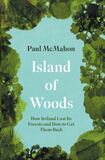
“The dirty secret of Irish forestry is that around one-third of the forests are no good. The island is full of zombie forests that shouldn’t be there in the first place but can’t be cut down because it would cost too much or damage the environment. No one is quite sure what to do with them.”
This judgment bursts out in Island of Woods: How Ireland Lost its Forests and How to Get them Back, Paul McMahon’s hopefully-titled history of Ireland’s trees and forestry. An Irish-born history graduate from Cambridge, he makes a thorough and lucid job of the factual chronicle but as his tale swings into the present it gets quite fraught.
“All the problems assailing Irish forestry seemed to come to a head in 2020,” he writes. He quotes from Co Leitrim protests against “the creeping tide of conifers” in which “the sun rises late and goes down early”. A growing alliance of farmers and environmentalists is rejecting Sitka spruce plantations, not least on ecological grounds. And ash dieback disease has arrived to threaten Ireland’s wayside trees.
Beneath all this, however, is a social truth about rural Ireland and rooted in the colonial past: forestry isn’t seen as proper farming. In one survey 84 per cent of farmers said they would never put land under trees, no matter how generous the incentives.
A New Zealander in Dublin: ‘It feels like people work to live here as opposed to living to work’
Family fallouts: ‘I can’t describe the heartache of not having a relationship with my sister’
Zach Bryan in Dublin review: Gen Z’s Garth Brooks puts on a charming – and lengthy – show
How the death of an ‘old boy from Ireland’ in London-Irish suburb sparked a misguided viral appeal
McMahon gives due credit to Ascendancy landowners for planting their estates. Some 7,000 big houses had well-wooded demesnes, bringing in new species such as sycamore, beech and horse chestnut. In the two Irelands of the Ascendancy, English planters became protectors of woodland but farmers saw land planted with trees that could have fed families and forestry remained an alien import.
Even as nationalists found their own enthusiasm for it, estates were broken up for farming or planted with conifers by the state. Government plantations were often confined to wet and gale-swept peatland and unproductive marginal land. Sitka spruce has suffered windthrow, lodgepole pine has grown crooked and tangled lodgepole forest in north Mayo is abandoned to “rewilding”.
For all the “faux Celticism” of pagan reverence for trees, says McMahon, potent myths still surround the deforestation of Ireland. Half the land was already cleared for farms and trade in timber by the end of the Bronze Age. Modern pollen research shows that Ireland’s oakwoods were never as dense at the Tudor conquest as has been claimed.
McMahon echoes the question posed by the eminent Cambridge ecologist Oliver Rackham: why were all the trees allegedly felled in Ireland never allowed to grow back from their roots? English settlers fed ironworks with charcoal from coppiced, well-managed oak forest. When the ironworks were finished economically, the trees were grubbed out by local cattle farmers.
Continuous forestry lets in more light, invites regeneration and offers a more natural fit to the landscape
How far do Irish people still believe that, on orders from Queen Elizabeth and others, Ireland’s oaks were cut down to build the Royal Navy? “It is an opinion,” McMahon avers, “you are likely to hear from the man or woman in the pub, the driver of a Dublin taxi, or most people who have been through the Irish school system. This was long the view of Irish nationalist historians as well.” Irish oaks did indeed help build ships for the East India Company and supply enough barrel staves to cask the wine of France and Spain.
How “alien”, after all, are the state’s dark plantations of Sitka spruce? McMahon salutes the choice of tree, growing two or three times faster in Ireland than in Scandinavia. “Anyone who plants broadleaves,” he writes, “is doing it for love, not the money.” But he does regret Ireland’s adoption of “scientific” plantation-based forestry developed in Germany in the 19th century “just as German foresters were beginning to have second thoughts”.
[ We culled our herd and planted Sitka spruce. Why am I still the bad guy?Opens in new window ]
This brings him to endorse the continuous-cover forestry practised now in about a quarter of European forests. Devised by expert foresters of the Pro Silva movement, it grows mixtures of conifers and broadleaves and thins them for a selective, spaced-out harvest of bigger trees. It dispenses entirely with clear-felling that, as McMahon describes, wipes out forest species, “setting the ecological clock back each time”.
Continuous forestry lets in more light, invites regeneration and offers a more natural fit to the landscape. Coillte, the state forest agency, is now introducing it in schemes for restoring native woodlands, but McMahon wants it used to replace the conifer plantations. “It might offer a way out of the war,” he suggests, “that has paralysed the Irish forest sector.”












